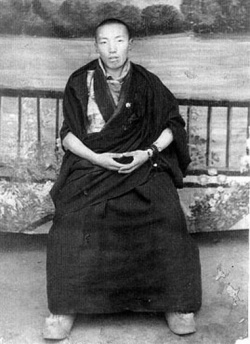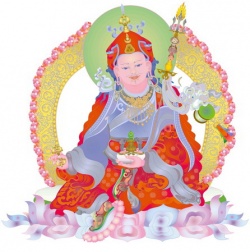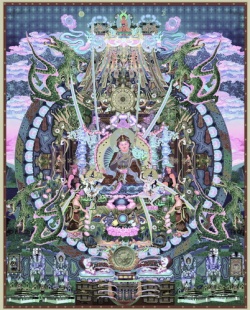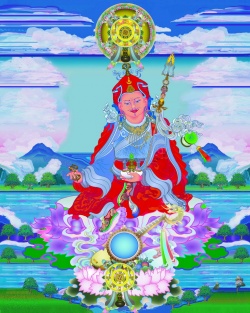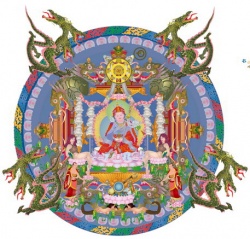Sixth Incarnation of Dzogchen Rinpoche
Sixth Incarnation of Dzogchen Rinpoche
Jigdral Jangchup Dorje
The Sixth Dzogchen Rinpoche was born in the southern region of Glorious Tsari, a supreme place where dakas and dakinis naturally gather. The previous Lord had predicted:
In the city [to the] north, just north
Of the special and sacred place of glorious Samye,
With Upaya [father] and Prajna [mother] bearing names adorned by the syllables of Ei and U,
In the pure family known as Sunudeva,
Displaying the new signs and characteristics of entering [the womb] and birth,
Connected for many lifetimes,
The Lord of Drekpas, supreme deva,
Mightiest among all the protectors [in] the Four [[[Directions]]]
Through the power of his inviolate vajra-oath
Will arise soon to hold and glorify the seat.
In many writings, numerous other noble beings, speaking in one voice and as if of one mind, praised him as the unmistaken [[[incarnation]]], and so he was born with many great, good signs. He was my Lord of the Buddha family, endowed with the three types of kindness, protector of the mandala, sitting on the golden throne, held up by lions, and his name, Orgyan Jigdral Jangchup Dorje Sisum Wangyur Tsungpa-mepe De, when actually expressed, was like a banner flying atop the peak of existence.
From a very young age, his knowledge and discernment were incomparable. He learned the arts of reading, writing and other skills just through a glance, when ordinary people would have needed months or years to learn. Within a short period of time, he learned all the ten aspects of knowledge without any difficulties. He took Ultimate Great Vajradhara, Tadrin Yonten Gonpo Khenpo Gönri as his master, and was never separated from him, [always engaging in] the three ways of delighting the guru. From him he received Patrul Rinpoche's Words of My Perfect Teacher, Longchenpa's Seven Treasures, Nyingthik Yabshi, and many other oral instructions, and he easily perfected his hearing and contemplation [of those transmissions].
At the age of eight, he was ordained as a novice monk, in accordance with the Vinaya, took the seat of Vajra-master and headed the Bumdrup, where thousands of monks gathered in the auspicious situation perfected as to place, time, retinue, and teacher. At that time, the sun, moon and the stars gathered [together] in the sky. Even though it was in the middle of the cold winter, the dragon's voice thundered, Ug-chö flowers blossomed, and many other wondrous signs arose, indicating that the higher beings, including gods, were paying their respects. The ten suchnesses, eight natures and the other qualities described in the Vajrayana texts were all complete [in this master]. Those fortunate ones, who had gathered for the first time, were placed on the path of ripening and liberation [through performing empowerments and reading-transmissions].
At the age of ten, he took Jamgon Chokyi Lodro as his Lord of the Buddha family, and studied with, and received full and complete teachings, empowerments, transmissions, and key instructions of the Old and New Translation School from: Khenchen Pema Thekchok Loden, Trulshik Kunga Palden, Nyidrak Rinpoche Thupten Shedrup Tenpe Nyima, Lingtrul Thubten Nyinje Gyatso, Gyarong Namtrul, Khenzur Thupten Nyendrak, Khensur Pema Tsewang, Khenpo of Dza Chanma – Thupga, Mira Pema Norbu, Gewae Shenyen Tsultrim Lodrö, Yapje Ngakwang Norbu, Drikhung Terchen and many others. He practiced the different sadhana practices of many yidams, giving rise to the signs as evidence of his accomplishment.
From the age of seventeen, he assumed religious and secular responsibilities. He expanded the activities of the lineage, commencing his great work in securing the sanctuaries of the doctrine [tib. rten], from establishing specific rules and disciplines — "dharmic do's and don'ts" — like a silk-knot composed of the three vows, to expanding the [number of] Drubwang Dzogchenpa's affiliate monasteries to more than two hundred and fifteen. His activities pervaded all aspects of space. Ablaze with supreme knowledge, he manifested the eloquence of the eight treasures and taught from memory the Madhyamaka, Abhisamayalamkara, Abhidharmakosha, Vinaya, King of Tantras – the Guhyagarbha tantra, Yönten Dzö, and other Indian and Tibetan scriptures on sutras and tantras. All appearances unobstructedly arose as symbols and instruction texts, and he became pre-eminent among scholars in explication, debate and composition. As a sign for common students of the wisdom of his meditative accomplishment, he left hand-prints on rocks, imbued pieces of his clothes with the power to release fear of sickness and evil-spirits, bestowed protection from the harm of weapons, and, through the samadhi of overpowering others' appearances, subdued the Eight Classes [of gods and spirits] so that they fulfilled the commands of the activities. His common and uncommon wondrous activities like these were inconceivable.
At age twenty, he travelled to Ü [[[Wikipedia:central Tibet|central Tibet]] on pilgrimage] and made offerings at Jowo, Shakyamuni, and [locations of] other sacred statues, scriptures, stupas, temples, monasteries, retreat places, Border Temples, and Further Subduing Temples, District Controlling Temples, and many others; as well, he made aspirations for the flowering of the Buddha dharma and for peace and happiness in the world. The Great Knower of the Whole Extent of the Upper Realm [[[Dalai Lama]]], gave him the title of "Maha-Pandita-Erteni-Ho-Thok-Thu" and graced and honoured him with many other precious articles.
During this time, most of the people and monasteries from the three Cholkas were planning to go into exile in foreign countries, so this supreme leader, whose activities, like the buddhas and bodhisattvas, were motivated by the supreme intention, returned back to the seat Rudam Dzogchen Monastery again. With pure aspiration, he made abundant offerings of tea, food, and materials to all the monasteries and dharma centres in Tsang, Ü, and Kham, and bid farewell. He restored the monastery, temples and shrines at the main seat [[[Dzogchen Monastery]]] that had been damaged by earthquakes and fire during the previous five incarnations. In order for the teachings of Buddha, the source of all happiness and benefit, to remain a long time in this universe, and for the holders of such teachings to remain for hundreds of aeons, and to ripen the great aspirations to benefit sentient beings, he built the three-storied Buddha statue (gold-plated on copper), the statues of Nyingthik Tsasum [[[Three Roots]]], the wondrous, glorious three dimensional mandala of Zangdok Palri, the big stupas made of silver and gold, and the statues of the five previous Drupwang Dzogchen Rinpoche.
He also started the continuous practices of Lama Gongdü of Sangye Lingpa and thirteen other terma drupchen. On top of the old tradition of 100,000 butter lamp offerings, he added 10,000 more butter lamps. Supplementing the material wealth used as the basis for the monthly or annual drupchens, he contributed great amount of additional materials for the practices. He laid the foundation for adding one hundred new shedra students, eighty new retreatants, gathered an assembly of monks to practice and chant at a Protector Shrine Temple of Wangdrak Rolpa, and so on with purely ordained monks, a new Shitro Temple, new Lama Gongdü and Shitro Drubchens, and sacred tantric dances.
At the age of twenty one, he received the full monastic ordination of a bikshu. He kept the discipline [[[pure]]]: outwardly, his Pratimoksha vows of Vinaya remained untainted with any downfalls; inwardly, he exhibited the actions of the heirs of the Buddha and bodhisattvas, engaging in compassionate deeds and never giving up on a single sentient being; and secretly, he maintained perfectly pure samaya vows and practiced the two stages of the Three Sections of Maha Ati and the Nine Spaces of Longde which he developed to the royal stage of the great yogis. Disciplined and noble and endowed with the rich qualities of learning, his activities of teaching, practice, and action pervaded space, and his fame spread beyond India and China, all the way to the ends of the earth.
At the age of twenty four, having restored the general and specific basis of the teachings, he decided to urge all his disciples to renounce the attainment of wealth, which, as taught, inevitably must end in losing all accumulation, and coming together, which inevitably must end in separation, and the rest. Accordingly, he made [this teaching] his heart aspiration, and divided into four all the treasure of the Dzogchen Rinpoche's Labrang. One fourth he gave away as newly created offerings to the sanghas of all the traditions who held, preserved, and expanded the sutra and tantra doctrines of the Buddha, as well as offerings for continuous reading of precious words of the buddha and recitation of special mantras for many days. Another fourth was offered for making hundreds of thousands of butter lamps and other infinite clouds of offerings, hundreds of thousands of feast offering of Sampa Lhundrup, ritual practices for mending downfalls and purifying negative actions and so forth, dedicated to the happiness of world. The third quarter was offered to that great seat's Dzogchen's monastic sangha and to those poor and ill people who had no relief or protection from poverty, and in this way further opening the great door of generosity. The final fourth was offered to the monastic sangha of Shedras, Drupdras, and retreatants, to provide the material basis of support for their special vajrayana ritual practices.
Once again, all the material wealth accumulated during the six incarnations was distributed among all the monastic sangha as appropriate. All the restricted sacred statues and other objects were revealed to all and he granted public empowerments using these sacred statues and objects. All the religious and secular disciples, young and old, monastics and lay, gathered, and he gave them the nectar of his essential advice and teachings to benefit their current and future lives. To the young, he gave the profound instructions for enhancing the longevity of life, and for the elders, he gave Phowa practices. Based on the auspiciousness of being gathered in one mandala at that time, he gave rise to the aspiration of meeting them again in their future lives in one mandala.
With such pure knowledge of the past and future, and because he had practiced such distinctively [beneficial] activities, even his acts of inhaling and exhaling became the cause for benefiting countless beings. Since he was habituated in the equanimity of compassion [towards all beings] and had practiced the intentions and actions of bodhisattvas for a long time in the past, like the sun rising, [his beneficial activities] arose spontaneously and naturally. Everywhere unfurling the white banner of the two pure traditions [secular and non-secular] — raised aloft on the unchangeable strong golden pole, embraced tightly and held above their crowns by the mighty gods, nagas, and many other higher beings, and ornamented at its apex by the coil of the many brilliant qualities of the nine genuine principles — he became a wish-fulfilling jewel for beings.
At the age of twenty five, having fulfilled the activities of his actual physical body and because of outer obstacles, his rupakaya dissolved into space, appearing as if resting in a peaceful state.
The spontaneously present nature of all Buddhas is inconceivable compassion in benefiting beings and all-pervading, everlasting activities arising from teaching activity. In particular, because this supreme guide directed his wisdom-mind to special activities, greatly benefiting limitless number of beings, and displayed a youthful appearance in this world during this golden age, and, through his profound teachings, ripened the glorious qualities of samsara and nirvana, his benefiting activity was much greater than that which resulted from the acts of his actual form kaya. It is certain that the complete limits of [his] wondrous visions and aspirations for ordinary beings are immeasurable. Through his past cultivation of bodhicitta, he has never for even for an instant abandoned sentient beings, who are as pervasive as space, and his compassionate deeds are of immeasurable extent.
Seeing with a special purpose, therefore, here is how he passed into nirvana. At dusk on the first day of the first Tibetan lunar month in the Earth Tiger year, he straightened [his posture] like an arrow, in the seven postures of Vairochana and meditated for a moment with the dharmakaya eye gaze. Even though untainted by any illness [or pain], he departed into the inner space of dharmata through the highest dharmakaya Phowa of all the profound path of instructions on Phowa [transference of consciousness]. When he passed beyond, the earth shook, the sky became completely clear, and a beautiful odour arose to all the disciples. When he was later cremated, a rainbow tent graced the sky and his relics spread out across the earthd many other wondrous signs were seen by all the beings present at this final activity, so much so that all beings who heard of it were greatly amazed.
